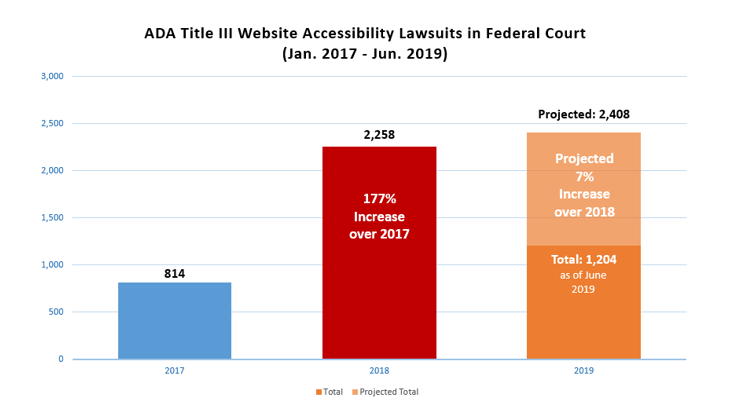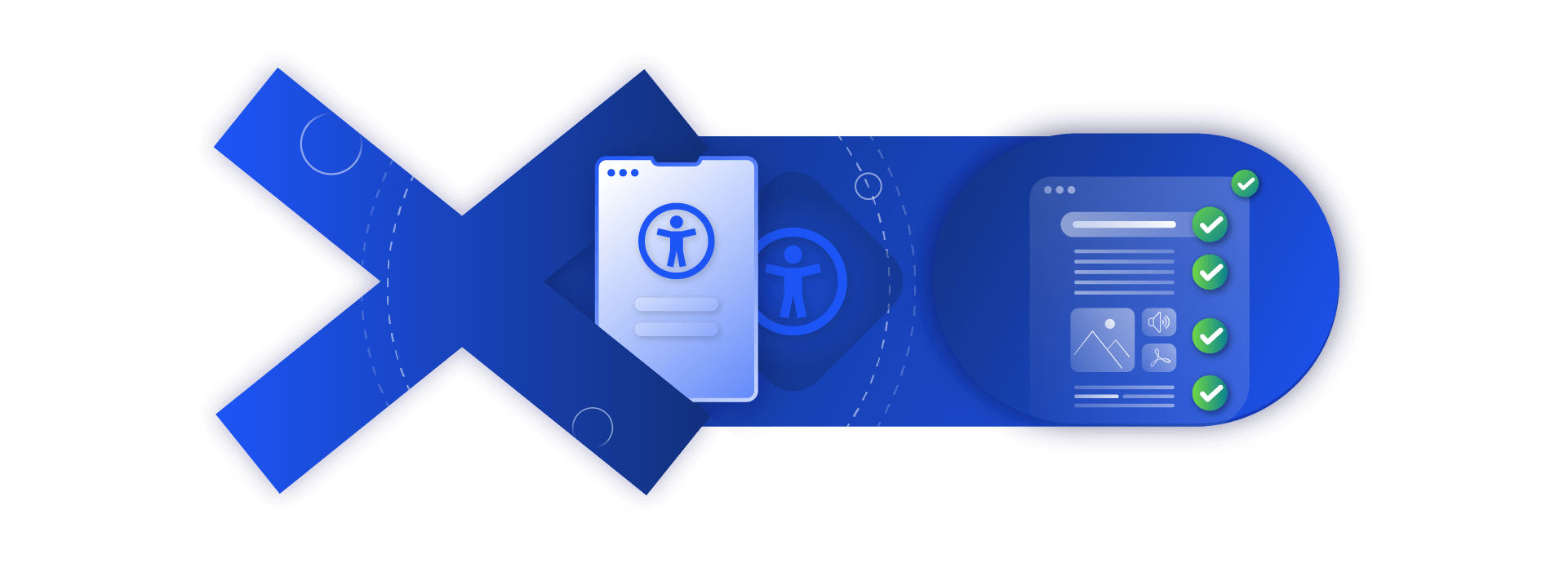Why the private sector needs to plan for digital accessibility
- By Jessica Navarro - Updated Nov 23, 2021 Web Accessibility
Raised awareness on the difficulties created by inaccessible digital technology for people with disabilities has led to a growing demand for accessible websites and an increase in digital accessibility regulations.
For instance, by September 23, 2020, the EU will require all public sector websites to follow standardized accessibility requirements with the aim to make essential information and services accessible for everyone.
Where does that leave private businesses both in and out of Europe? There are several reasons why now is the perfect time for your business to start planning for web accessibility. But first, it’s important to understand what accessibility is and why it matters.
What is web accessibility?
Web accessibility is a way of designing websites, tools, and technologies so that everyone, including people with disabilities, can use them as easily as possible.
There are different types of disabilities to consider when designing accessible websites and digital media:
- Blindness and low vision
- Deafness and hearing loss
- Limited movement
- Speech disabilities
- Neurological limitations (e.g., Alzheimer's, Parkinson’s, and sensitivity to flashing lights)
- Cognitive limitations (e.g., learning disabilities)

When building an accessible website, you can use a range of different design and web development practices that help people with disabilities navigate the site. For example, by ensuring sufficient color contrast between the text and background colors on your site, you make it easier for those with low vision to read the text.
Why accessibility matters
In the EU, one in four people live with a disability or long-term limitations to their everyday activities. In the U.S., there are over 56 million people living with a disability. Although digital technology has made some activities easier for people with disabilities, many products, services, and information are moving online without accessibility in mind. Poorly-designed and inaccessible tech is making it difficult for people with disabilities to participate in daily life.
Elderly consumers are another group struggling with digital technology. Complicated online forms, lack of adequate contrast ratio, and poorly organized checkout flows while shopping online can all make a website unusable.
For the elderly and people living with disabilities, access to essential online services for public institutions, like health centers, police stations, and administrative offices, is also endangered by inadequate digital accessibility.
Even with assistive technologies—such as screen reading software that reads the content of the computer screen aloud for blind or visually impaired people—a cluttered website with unclear text and missing metadata descriptions creates unnecessary obstacles that can be avoided.
Simply put, if your website is not accessible, you are excluding a significant percentage of the global population, which not only threatens disabled people’s rights to the same opportunities as abled people, but also has consequences for your business.
Why you should make your company’s website accessible
So how does accessibility impact your business? Let’s go over the benefits for your business if you start designing and building websites with accessibility in mind.
Widen your reach to a broader audience
There are over one billion people living with disabilities around the world who have an estimated spending power of more than $6 trillion. By building an accessible website, you are thereby widening your audience and increasing your prospective customers.
With the majority of the baby boomer generation reaching the age of 60 and over, we can expect to see an increasing amount of consumers with buying power to begin experiencing a decline in their cognitive functions by 2030. This decline includes a diminished working memory, as well as difficulties in decision making. Businesses should be prepared to accommodate this group with easy to use websites that prioritize clear text, clean and uncluttered pages, and, if you’re an e-commerce site, simple ordering and checkout flows.
Get ahead of increasing regulation
Some countries have already taken steps towards regulating and enforcing web accessibility, mainly within the public sector. However, more countries are beginning to apply requirements on private businesses and organizations, as well.
For instance, the EU Directive 2019/882 on the accessibility requirements for products and services aims to make it easier to trade accessible products and services, such as ticketing machines, ATMs, computers, and mobile devices, between EU member states by harmonizing the laws and regulations for these products. This directive entered into force June 27, 2019 and we can expect member states to adopt the directive’s requirements into their national laws by the deadline on June 27, 2024.
Canada introduced the Accessibility for Ontarians with Disabilities Act (AODA) in 2005, which requires all the public sector and private or non-profit organizations with more than 50 employees to have accessible websites by January 2021. Those who fail to comply could face fines of up to $100,000 for each day of violation. Take a look at our complete overview of Canada’s accessibility laws for more information on AODA and other legislation in Canada.
Norway has taken their regulations further by making it a legal requirement for all websites, mobile apps, and self-service machines to comply to universal design practices, which they refer to as Universal Design of ICT (Information & Communications Technology). Norway’s enforcement efforts are notable as they’ve appointed Difi, the Norwegian Digitalization Agency, to regularly carry out random checks.
We can expect to see further developments in accessibility regulations around the world, as policies catch up to the digital age. Even if your country does not enforce policies that specifically point to web accessibility, it’s important to be aware that you are still responsible for providing adequate services for people with disabilities.
Many existing governmental policies across the globe refer to the Web Content Accessibility Guidelines (WCAG) 2.0 or 2.1 Level AA as the standard requirements for accessibility. Rather than wait for your country to enforce deadlines on you, get a head start by becoming familiar with WCAG 2.1 now.
Avoid the risk of lawsuits
The U.S. has experienced an increasing amount of web accessibility lawsuits filed in federal and state courts, from 814 lawsuits in 2017 to at least 1,204 lawsuits in 2019.

A case that has received extra media attention is an ongoing lawsuit against Domino’s Pizza. Guillermo Robles, who is blind, filed the lawsuit after unsuccessfully trying to order a pizza through Domino’s website, despite using screen reading software.
Robles claims that Domino’s failed to provide an accessible online service that equated the service received by a sighted person, thereby violating his rights as outlined by the American Disabilities Act (ADA) Title III regulations. Title III prohibits discrimination on the basis of disability in places of public accommodation, meaning businesses that offer services to the public, such as restaurants and movie theaters.
Whatever the outcome of the case, the takeaway is that businesses need to treat accessibility as a legal necessity, rather than a nice-to-have option. The Robles vs Domino’s case has demonstrated that accessibility laws and how they’re interpreted don’t always align. However, by tuning in to the needs of your customers with disabilities and addressing the most common accessibility issues, you can improve your chances of avoiding legal scrutiny.
Build brand loyalty by meeting the demand for social responsibility
Your audience today consists of conscious consumers, meaning they support businesses who align with their values on social, environmental, and political issues.
In a survey by Accenture in 2018, 51 percent of younger millennials (age 21-27) were more likely to shop at a retailer that demonstrated an authentic commitment to inclusion and diversity, with regards to age, gender, ethnicity, and disability. And 69 percent of older millennials (age 28-37) surveyed were more likely to choose one brand over the other if that brand demonstrated inclusion and diversity in its promotions.
Companies have already responded to this demand by shaping socially responsible messaging that highlights topics like sustainability and diversity. However, as the survey above highlights, people look for an authentic commitment from the brands they buy. This means a one-off marketing campaign is not enough.
Instead, incorporate inclusive values directly into your brand, product, and services. For example, by instilling accessible web and design practices into your daily work processes, you can show your commitment to creating an inclusive user experience. Otherwise, you risk that customers who need accessible websites choose another brand over yours. In a UK study in 2016, 71% of customers with disabilities click away if a website is difficult to use. And yet, disabled customers have shown to be loyal customers who spend more once you earn their trust.
“82% of participants with access needs said they would spend more if websites were more accessible.”
Source: The Click-Away Pound Report 2016
Boost user experience and innovation
At the core of accessibility design is usability. We have already experienced a shift to user-centered design that focuses on understanding users’ needs and behaviors in order to build products that create the best user experience (UX). By designing the UX of your site with accessibility in mind, you can elevate your site’s usability to new heights.
Moreover, designing for accessibility can lead to innovative solutions you might not have reached otherwise. As an interview with the Director of Google AI, Eve Andersson, highlights, tech that we all use today, such as voice control and autocorrect, started as features designed for people with disabilities to more easily use computers. This trickle-down effect, Andersson argues, demonstrates that solving today’s accessibility problems could lead to future tech breakthroughs that benefit society at large.
An instance where an accessibility problem unwittingly lead to such a breakthrough is Vint Cerf’s contributions in the ARPANET project in the 1970s, which eventually became today’s Internet. Cerf helped develop one of the early forms of email, in part because he has a hearing impairment and wanted a way to communicate more easily with his colleagues. Although Cerf admits that accessibility was not something they were thinking of at the time, he now sees how “accessibility and ease of use go hand in hand” and urges tech creators to include accessibility in the design phase of any product.
Start building an accessible website
If you are reading this blog post, then you are already on the first step towards an accessible website, which is understanding accessibility and why it’s important.
The next step is assessing your website for accessibility issues, so you can begin preparing an actionable plan.

Some things to look for when assessing your website for accessibility include:
- Proper page structure
- Useful page titles
- Clear, simple text
- Sufficient color contrast ratio
- No distracting animations or flashing lights
- Accessible links and link text
- Accessible images, audio, and captioned video
- Accessible documents (PDFs, Word docs, spreadsheets, etc...)
To get a better understanding of the general accessibility principles, legal implications, and more, join our free online course Accessibility fundamentals for the web.
Still in doubt about where to begin? Take a look at our post How to prepare your public sector website for the EU Web Accessibility Directive deadline for a step by step guide on preparing a plan for accessibility. Although the post is aimed at public organizations and refers directly to the EU Web Accessibility Directive, the steps to preparing an adequate accessibility plan remain the same.

